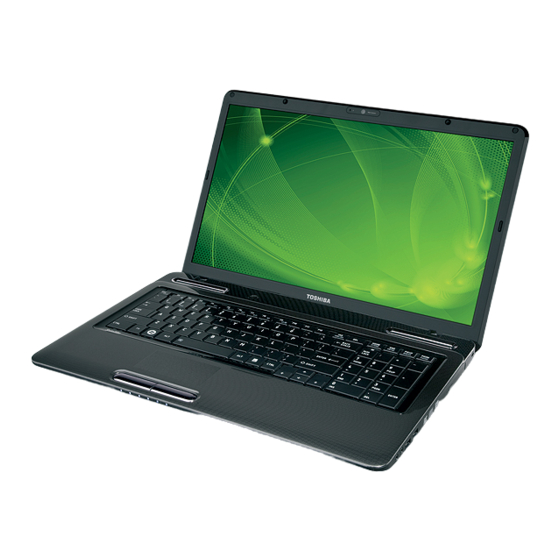
Toshiba Satellite L670 User Manual
L670-bt2n23 user's guide
Hide thumbs
Also See for Satellite L670:
- Maintenance manual (255 pages) ,
- User manual (222 pages) ,
- Owner's manual (199 pages)
Table of Contents
Advertisement
Quick Links
Satellite
User's Guide
If you need assistance:
❖
Toshiba's Support Web site
pcsupport.toshiba.com
❖
Toshiba Customer Support Center
Calling within the United States (800) 457-7777
Calling from outside the United States (949) 859-4273
For more information, see
page 163
®
L670 Series
in this guide.
"If Something Goes Wrong" on
GMAD00245010
03/10
Advertisement
Table of Contents

Summarization of Contents
Warranty and Legal Information
Recordable and/or ReWritable Drive(s) and Associated Software Warranty
Warranty terms for optical drives and associated software.
Protection of Stored Data
Guidelines and disclaimers regarding data protection and loss.
Safety and Compliance
Critical Applications
Disclaimer on using the product for critical applications.
FCC Notice “Declaration of Conformity Information”
FCC compliance statement and interference guidelines.
Regulatory Requirements
Industry Canada Requirement
Compliance with Canadian ICES-003 standards.
FCC requirements
Detailed FCC requirements for modem-equipped computers.
Introduction
Safety icons
Explanation of safety icons used throughout the manual.
Service options
Information on available service programs and extended warranties.
Chapter 1: Getting Started
Selecting a place to work
Guidance on choosing an appropriate workspace for the computer.
Setting up your computer
Steps for initial computer setup and connection.
Charging the main battery
Instructions on how to charge the computer's main battery.
Chapter 2: Learning the Basics
Computing tips
Essential tips for effective computer usage and data management.
Using the keyboard
Explanation of keyboard layout, keys, and their functions.
Saving your work
Procedures for saving documents and data to prevent loss.
Chapter 3: Mobile Computing
Running the computer on battery power
Information on using the computer without AC power.
Power management
Overview of system power management settings.
Chapter 4: Exploring Your Computer’s Features
Exploring the desktop
Introduction to the Windows desktop environment and its components.
Setting up for communications
Guidance on connecting to networks and communication services.
Chapter 5: Utilities
TOSHIBA Assist
Accessing and using the TOSHIBA Assist utility for system management.
Setting passwords
Procedures for setting and managing system passwords.
Chapter 6: If Something Goes Wrong
Problems that are easy to fix
Troubleshooting common software responsiveness issues.
The Windows® operating system is not working
Diagnosing and resolving issues with the operating system.
Appendix A: Hot Keys and TOSHIBA Cards
Hot Key Cards
Overview of Hot Key Cards for system function modification.
Application Cards
Using Application Cards to launch specific software.
Hot key functions
Detailed explanations of various hot key functions.




Need help?
Do you have a question about the Satellite L670 and is the answer not in the manual?
Questions and answers